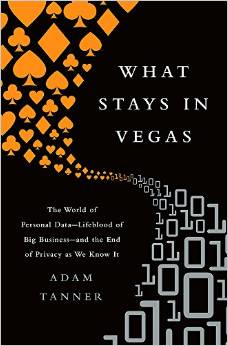 Adam Tanner’s new book, What Stays in Vegas: The World of Personal Data – Lifeblood of Big Business – and the End of Privacy as We Know It, is both enlightening and frightening. Tanner, a fellow at the Institute for Quantitative Social Science at Harvard University, has also been a reporter and bureau chief for several news agencies and newspapers. His writing exhibits the thoroughness of an investigative reporter and the intellectual curiosity of someone searching for an answer not yet available.
Adam Tanner’s new book, What Stays in Vegas: The World of Personal Data – Lifeblood of Big Business – and the End of Privacy as We Know It, is both enlightening and frightening. Tanner, a fellow at the Institute for Quantitative Social Science at Harvard University, has also been a reporter and bureau chief for several news agencies and newspapers. His writing exhibits the thoroughness of an investigative reporter and the intellectual curiosity of someone searching for an answer not yet available.
Tanner’s story begins with the casinos in Las Vegas, shortly after the September 2001 terrorist attacks in New York City and Washington, D.C. In the wake of a steep decline in air travel and concern over future attacks, the casinos began building rewards programs to attract gamblers. In the process, a lot of internally-collected data was appended to individual gamblers’ data files and, eventually, some casinos also added third-party data.
Tanner’s first stop in his story is the office of Caesar’s Entertainment CEO Gary Loveman, a former faculty member at the Harvard Business School (HBS) and co-author of a groundbreaking 1994 article about the lifetime value of loyal customers. After working as a consultant to Harrah’s executives, Loveman wrote to Harrah’s then CEO suggesting ways to use the data they collected to build customer loyalty. Harrah’s CEO, Phil Satre, recruited Loveman as chief operating officer and Loveman subsequently implemented the customer rewards programs at all Caesar’s properties utilizing high-level data analytics, increasing Harrah’s revenues and profitability. As part of the research for this book, Tanner proposed spending a year studying how Caesar’s collects data on its customers, and Loveman agreed.
While the leadoff story is about Caesar’s data collection and the development of its customer rewards program, the book also discusses some of the major companies that collect data on consumers. Their consumer data ranges from marriage licenses and criminal convictions to credit ratings and salary and family information, etc., which is then brokered to other companies (excluding some financial, medical, and education data which have government regulations limiting information distribution). Tanner discusses the ethical considerations of using third-party customer data in conjunction with internally generated customer data, an issue that some companies consider more seriously than others.
Executives interviewed by Tanner at Caesar’s and Disney discuss the importance of not alienating customers by recommending promotions not pertaining to information harvested by their companies. Tanner writes about several startup companies seeking consumers to provide personal information in return for a percentage of fees paid by businesses to them (the customer) to access their files. He states that every company collecting data on individuals should be required to share that information with the individual when asked. His stated rationale is not to slow down the wheels of commerce, but to make people feel better about the process and the accuracy of the data.
The amount of personal information collected on individuals in the future will most likely increase, particularly with the expansion of technology to “the Internet of Things” where devices like Fitbit can record your daily steps and sleep patterns. Tanner’s book is a valuable resource for individuals interested in this topic as well as executives debating how to use data to increase the loyalty of existing customers or solicit new ones.
While there are many books addressing predictive analytics and big data, this is the first I’ve read that provides a thorough discussion of the pros and cons of data collection and the impact on both individuals and companies.











